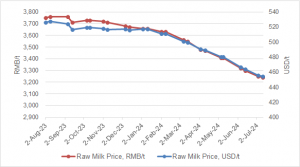
Evershed’s research team separated compounds of up to two grams from pottery samples and detected very small traces of fatty acid carbon in milk, cheese and meat residues. The new technology could help reveal the dietary changes of prehistoric creatures.
Evershed’s discovery has been listed among the “Top 10 Discoveries of 2020” by Archaeology, an influential journal published by the Archaeological Institute of America.
Diet has always been a subject of great interests in archaeology, as it offers important clues for the study of human development. Research has found that frescoes in a temple in Babylon dating back about 6,000 years are the earliest historical records of humans cultivating and drinking milk. Milk’s values are not limited to its nutrients. A closer study of it over the centuries could reveal the change and development of human society and even patterns of global civilizations.
Milk and dairy products were not popular in Europe until the 19th century. As milk was not easy to preserve and was apt to sour it became a breeding ground for bacteria without refrigeration. For that reason milk was once banished as a food for the poor and the rich kept it at a distance.
New technologies changed that. Pasteurization, developed in the mid-19th century, gradually helped milk become a popular consumer good. With the emergence of trains and the advent of refrigerators in the 20th century, milk could be transported and became easier to preserve and gradually more popular worldwide.
Then came a major breakthrough. UHT (ultra high temperature) technology revolutionized milk consumption. In the 1960s, aseptic packaging and UHT treatment pushed the boundaries of sterilized milk processing, significantly expanding the transportation range of milk products while greatly improving their shelf life and safety. In Western European countries, the market share of UHT milk increased from merely 16 percent in 1974 to 54 percent in 2000.
Market acceptance, just like Rome, wasn’t built in one day and there have always been doubters and rumors along the way. China, in early days a stranger to UHT, was no exception.
There are still doubters wondering if preservatives were added, given that the storage time of UHT milk can be as long as five to eight months. Those privy to what UHT technology is will realize how unfounded that idea is.
UHT (ultra high temperature) sterilization milk, as the name indicates, involves treating milk at a high temperature (usually at least 135 C or 275 F) for one or two seconds .
UHT technology can basically eliminate bacteria. In a hermetically sealed environment, milk processed in this way can be kept for several months or even longer without refrigeration. Therefore, its safety level is higher as it poses a lower risk of bacteria and microbial toxins.
There are also concerns about UHT milk’s nutritional value. Some fear that high temperature will hurt its original nutritional components.
According to dietary guidelines issued by the Food and Nutrition Service of the US Department of Agriculture, UHT milk is fresh milk, and if unopened does not need refrigeration for storage since it uses a distinct process to kill bacteria while maintaining its flavor and nutrition.
At a seminar held by the China Food Information Center in 2019, experts from the China Food Safety Risk Assessment Center, the Nutrition and Health Institute of the Chinese Center for Disease Control and Prevention, Peking University, China Agricultural University, the China National Research Institute of Food and Fermentation Industries and the Health Communication Society of the Chinese Preventive Medicine Association all agreed that consumers are free to choose whatever dairy products they like on the Chinese market since milk products, including pasteurized milk, milk powder and yoghurt as well as UHT milk are all good and safe sources of high-quality protein and calcium.
From a global perspective, UHT milk’s market shares vary, influenced by each country’s circumstances such as drinking habits, milk sources, production conditions, storage and transportation, and really have nothing to do with UHT milk’s nutritional value.
UHT milk’s market shares in Belgium, Spain, and Portugal reach as high as 96.7 percent, 95.7 percent, and 92.9 percent respectively. In Germany and Italy it’s about 60 percent and in Switzerland it’s nearly 50 percent.
In France, the birthplace of pasteurization, UHT milk has an impressive market share of 95.5 percent. Britain also plans to improve its UHT milk market share to 90 percent by 2020. Markets in countries like Japan, the United States and New Zealand may have less impressive shares for UHT milk because they have highly-developed animal husbandry and dairy industries.
Therefore, we should ensure that the sources of UHT milk are safe and reliable, instead of worrying about its shelf life and nutritional value. The nutrients of UHT milk are always stable during the product’s shelf life while its fragrance, purity and good taste are preserved. Nevertheless we should ensure that UHT milk is derived from high quality sources such as standardized and modern pastures.
Today, milk products on the market in China with a shelf life of six months are all rich in nutrients and taste. Sampling tests in various provinces and cities have shown that they have the highest qualification rates and are safe and reliable.
Technology has brought great convenience to our lives and provided a plenitude of healthy food. For centuries, people have been drinking milk. Right now the average milk consumption per person in the world is about 70 kg per year, and the figure in developed countries has reached 200 kg.
The dairy industry plays an essential role in promoting the “Healthy China” Initiative, and milk is an indispensable element of the diet of many Chinese.
China is catching up in its consumption of dairy products. Its dual priorities are greater milk consumption and better product safety. The market will prove that worries about UHT milk’s nutritional values are really a nonissue.

























